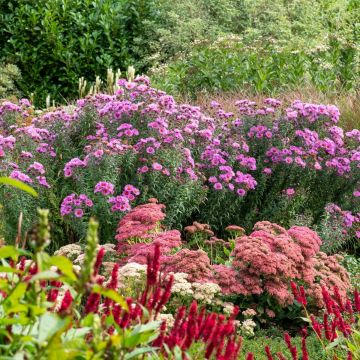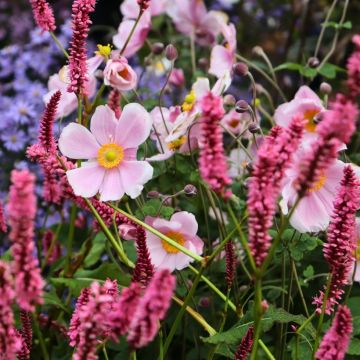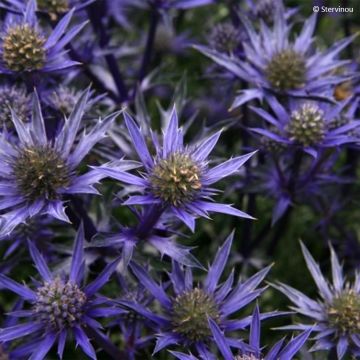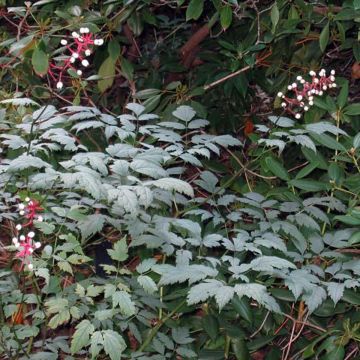

Colocasia esculenta x gigantea Noble - Taro
Colocasia esculenta x gigantea Noble - Taro
Colocasia esculenta x gigantea 'Noble' (GIGANTES series)
Elephant Ear, Taro
Special offer!
Receive a €20 voucher for any order over €90 (excluding delivery costs, credit notes, and plastic-free options)!
1- Add your favorite plants to your cart.
2- Once you have reached €90, confirm your order (you can even choose the delivery date!).
3- As soon as your order is shipped, you will receive an email containing your voucher code, valid for 3 months (90 days).
Your voucher is unique and can only be used once, for any order with a minimum value of €20, excluding delivery costs.
Can be combined with other current offers, non-divisible and non-refundable.
Why not try an alternative variety in stock?
View all →This plant carries a 12 months recovery warranty
More information
We guarantee the quality of our plants for a full growing cycle, and will replace at our expense any plant that fails to recover under normal climatic and planting conditions.
Would this plant suit my garden?
Set up your Plantfit profile →
Description
The Colocasia 'Noble Gigante' is a striking variety of Elephant's Ear, both due to its large size and its gigantic leaves that can reach up to 90 cm in length. Their colour varies throughout the seasons and depending on the exposure, but remains in a dark range, between shades of brown, purple, and black. The plant captures all attention, whether used as an indoor plant, to decorate a veranda, or in a large exotic bed in the garden. Well protected, its stump can withstand up to -8°C at its peak.
The Colocasia 'Noble Gigante' was selected in the United States by Brian Williams of Brian's Botanicals in Louisville, Kentucky. It is part of a series of giant and colourful hybrids derived from Colocasia esculente and C. gigantea called Gigantes™. Colocasia belongs to the family of Araceae, being cousins to Arums and Monsteras.
The cultivar 'Noble Gigante' is a perennial herbaceous plant that grows from a tuberous rhizome, forming a scaly corm covered with a thick skin. An adult specimen can reach between 1.8 and 2.4 m in height with a span of 1.50 m in a single season. Its elongated heart-shaped veined leaves measure between 60 and 90 cm in length. Their colour varies depending on the light, season, and age of the leaf. Young leaves often appear in green tones, then gradually turn purple before becoming purplish or blackish. In full sun, they take on a purple-blue hue, while in shade, they display a softer purple with green highlights. The leaf surface is generally matte, with light green veins turning dark purple. The underside transitions from cream beige to red in autumn. Each leaf is carried by a long blackish or purple petiole (stalk), enhancing the plant's theatrical appearance. The leaf surface is water-repellent, allowing water to slide off easily. During its growth, this colocasia branches out from the base, enabling some spreading. By removing an old leaf, two new ones take its place. This magnificent vegetation is deciduous: it emerges in spring and withers in autumn with the onset of cold weather.
The Colocasia 'Noble Gigante' captivates with its majestic habit and large colourful leaves that bring a beautiful "jungle" effect to the garden or indoors. To create a lush setting, plant this Colocasia in moist, well-drained soil rich in organic matter, in a partially shaded spot. Its strong personality pairs perfectly with other exotic species. The Canna 'Musifolia', reaching 2.50 m in height, with small orange flowers, will be a magnificent companion. For a contrast in texture, consider the Fatsia japonica, with its palmate bright green leaves. Complete your "jungle" bed with the Hosta 'Empress Wu', boasting large blue-green leaves. Its massive and imposing foliage will enhance the depth effect of this composition.
True taro is consumed in Africa, China, Polynesia, and several other parts of the world. Its tubers, rich in starch, and young leaves are consumed like spinach.
Report an error about the product description
Flowering
Foliage
Plant habit
Safety measures
Botanical data
Colocasia
esculenta x gigantea
'Noble' (GIGANTES series)
Araceae
Elephant Ear, Taro
Colocasia esculenta 'Noble Gigante'
Cultivar or hybrid
atteintescutaneomuqueuses
Cette plante peut provoquer l'apparition de réactions cutanées indésirables, une atteinte des yeux, ou des difficultés respiratoires si elle est ingérée.
Ne la plantez pas là où de jeunes enfants peuvent évoluer. Evitez tout contact avec la peau: privilégiez l'emploi de gants pour la manipuler. En cas de contact, lavez-vous soigneusement les mains et rincez abondamment à l'eau la zone concernée. Lavez les vêtements entrés en contact. En cas de réaction cutanée, contactez votre médecin ou le centre antipoison le plus proche de chez vous. En cas d'atteinte étendue ou de difficultés respiratoires, appelez immédiatement le 15 ou le 112.Pensez à conserver l'étiquette de la plante, à la photographier ou à noter son nom, afin de faciliter le travail des professionnels de santé.
Davantage d'informations sur https://plantes-risque.info
Other Perennials A to Z
View all →Planting and care
Plant your 'Noble Gigante' Colocasia in a sunny location or possibly in partial shade. They require a moist to wet, fertile and humus-bearing soil and appreciate a nitrogen-rich fertilizer, such as grass clippings. You can plant your Colocasia in large containers, with regular and generous watering during the growing season, and less frequent watering in winter. If the air is too dry in winter, the plants may be susceptible to attacks from red spider mites. Typically grown as greenhouse or conservatory plants, they are actually quite hardy perennials (down to -6/-8°C). You can grow them in the garden, by mulching the stump well in winter. If the soil is waterlogged in winter, the rootstock may rot, so the soil will need to be drained. In any case, the foliage is destroyed by frost. It regrows quite late in spring, as soon as the temperatures rise. Watch out for attacks from slugs and snails that enjoy feasting on the young leaves.
Planting period
Intended location
Care
This item has not been reviewed yet - be the first to leave a review about it.
Similar products
Haven't found what you were looking for?
Hardiness is the lowest winter temperature a plant can endure without suffering serious damage or even dying. However, hardiness is affected by location (a sheltered area, such as a patio), protection (winter cover) and soil type (hardiness is improved by well-drained soil).

Photo Sharing Terms & Conditions
In order to encourage gardeners to interact and share their experiences, Promesse de fleurs offers various media enabling content to be uploaded onto its Site - in particular via the ‘Photo sharing’ module.
The User agrees to refrain from:
- Posting any content that is illegal, prejudicial, insulting, racist, inciteful to hatred, revisionist, contrary to public decency, that infringes on privacy or on the privacy rights of third parties, in particular the publicity rights of persons and goods, intellectual property rights, or the right to privacy.
- Submitting content on behalf of a third party;
- Impersonate the identity of a third party and/or publish any personal information about a third party;
In general, the User undertakes to refrain from any unethical behaviour.
All Content (in particular text, comments, files, images, photos, videos, creative works, etc.), which may be subject to property or intellectual property rights, image or other private rights, shall remain the property of the User, subject to the limited rights granted by the terms of the licence granted by Promesse de fleurs as stated below. Users are at liberty to publish or not to publish such Content on the Site, notably via the ‘Photo Sharing’ facility, and accept that this Content shall be made public and freely accessible, notably on the Internet.
Users further acknowledge, undertake to have ,and guarantee that they hold all necessary rights and permissions to publish such material on the Site, in particular with regard to the legislation in force pertaining to any privacy, property, intellectual property, image, or contractual rights, or rights of any other nature. By publishing such Content on the Site, Users acknowledge accepting full liability as publishers of the Content within the meaning of the law, and grant Promesse de fleurs, free of charge, an inclusive, worldwide licence for the said Content for the entire duration of its publication, including all reproduction, representation, up/downloading, displaying, performing, transmission, and storage rights.
Users also grant permission for their name to be linked to the Content and accept that this link may not always be made available.
By engaging in posting material, Users consent to their Content becoming automatically accessible on the Internet, in particular on other sites and/or blogs and/or web pages of the Promesse de fleurs site, including in particular social pages and the Promesse de fleurs catalogue.
Users may secure the removal of entrusted content free of charge by issuing a simple request via our contact form.
The flowering period indicated on our website applies to countries and regions located in USDA zone 8 (France, the United Kingdom, Ireland, the Netherlands, etc.)
It will vary according to where you live:
- In zones 9 to 10 (Italy, Spain, Greece, etc.), flowering will occur about 2 to 4 weeks earlier.
- In zones 6 to 7 (Germany, Poland, Slovenia, and lower mountainous regions), flowering will be delayed by 2 to 3 weeks.
- In zone 5 (Central Europe, Scandinavia), blooming will be delayed by 3 to 5 weeks.
In temperate climates, pruning of spring-flowering shrubs (forsythia, spireas, etc.) should be done just after flowering.
Pruning of summer-flowering shrubs (Indian Lilac, Perovskia, etc.) can be done in winter or spring.
In cold regions as well as with frost-sensitive plants, avoid pruning too early when severe frosts may still occur.
The planting period indicated on our website applies to countries and regions located in USDA zone 8 (France, United Kingdom, Ireland, Netherlands).
It will vary according to where you live:
- In Mediterranean zones (Marseille, Madrid, Milan, etc.), autumn and winter are the best planting periods.
- In continental zones (Strasbourg, Munich, Vienna, etc.), delay planting by 2 to 3 weeks in spring and bring it forward by 2 to 4 weeks in autumn.
- In mountainous regions (the Alps, Pyrenees, Carpathians, etc.), it is best to plant in late spring (May-June) or late summer (August-September).
The harvesting period indicated on our website applies to countries and regions in USDA zone 8 (France, England, Ireland, the Netherlands).
In colder areas (Scandinavia, Poland, Austria...) fruit and vegetable harvests are likely to be delayed by 3-4 weeks.
In warmer areas (Italy, Spain, Greece, etc.), harvesting will probably take place earlier, depending on weather conditions.
The sowing periods indicated on our website apply to countries and regions within USDA Zone 8 (France, UK, Ireland, Netherlands).
In colder areas (Scandinavia, Poland, Austria...), delay any outdoor sowing by 3-4 weeks, or sow under glass.
In warmer climes (Italy, Spain, Greece, etc.), bring outdoor sowing forward by a few weeks.



























































